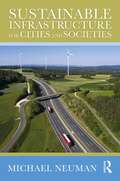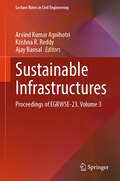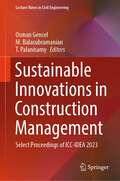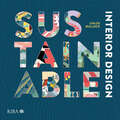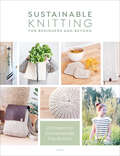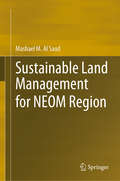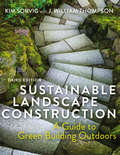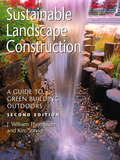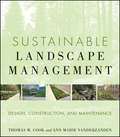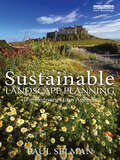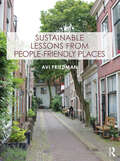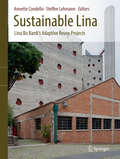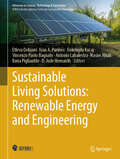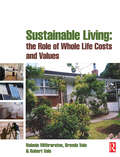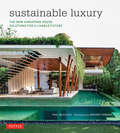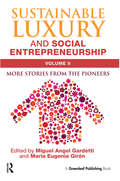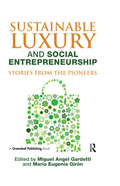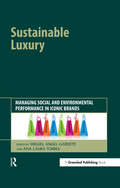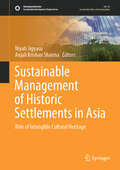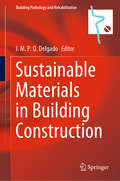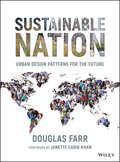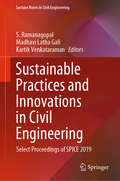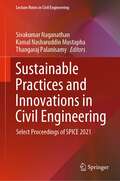- Table View
- List View
Sustainable Infrastructure for Cities and Societies
by Michael NeumanThe central role of infrastructure to cities, and in particular their sustainability, is essential for proper planning and design since most energy and materials are themselves consumed by or through infrastructures. Moreover, infrastructures of all types affect matters of economic and social equity, due to access that they provide or prevent. Sustainable Infrastructure for Cities and Societies shows how fundamental planning, design, finance, and governance principles can be adapted for sustainable infrastructure to provide solutions to make cities significantly more sustainable. By providing a contemporary overview on infrastructure, cities, planning, economies, and sustainability, the book addresses how to plan, design, finance, and manage infrastructure in ways that reduce consumption and harmful impacts while maintaining and improving life quality. It considers the interrelationships between the economic, political, societal, and institutional frameworks, providing an integrative approach including livability and sustainability, principles and practice, and planning and design. It further translates these approaches that professionals, policymakers, and leaders can use. This approach gives the book wide appeal for students, researchers, and practitioners hoping to build a more sustainable world.
Sustainable Infrastructures: Proceedings of EGRWSE-23, Volume 3 (Lecture Notes in Civil Engineering #355)
by Krishna R. Reddy Arvind Kumar Agnihotri Ajay BansalThis book contains peer-reviewed and selected papers presented during the International Conference on Environmental Geotechnology, Recycled Waste Materials and Sustainable Engineering (EGRWSE) 2023, held at NIT Jalandhar. It discusses the recent innovations, trends, concerns, practical challenges encountered, and the solutions adopted in waste management and engineering, geotechnical and geoenvironmental engineering, infrastructure engineering and sustainable engineering. This book can serve as a useful resource for researchers, educators, policymakers, and professionals working in the field of civil engineering, chemical engineering, environmental sciences, and public policy.
Sustainable Innovations in Construction Management: Select Proceedings of ICC-IDEA 2023 (Lecture Notes in Civil Engineering #388)
by M. Balasubramanian Osman Gencel T. PalanisamyThis book presents the select proceedings of International Conference on Civil Engineering: Innovative Development in Engineering Advances (ICC IDEA 2023). This book covers the latest research in the areas of construction engineering and management, urban planning and design, building energy conservation and green architecture, materials science and engineering, innovation in construction materials, and information technology in civil engineering. The book is useful for researchers and professionals in civil engineering.
Sustainable Interior Design
by Chloe BullockWhat does it mean to be a sustainable interior designer? Where do you start? This book demystifies how to be a sustainable interior designer, both within practice and on design projects. It gives you the tools to educate clients that sustainable practice isn’t necessarily more expensive, and what the options available to them are in terms of design concept, materials and finishes. Importantly, the book also looks at sustainable supply chains, particularly important when specifying FF+E. Where to start being sustainable can be a difficult decision. Acting as a primer for interior designers at any stage of their career, it outlines what you really need – and don’t need – to know. Inspirational case studies from around the world sit alongside crucial guidance on the benefits of being sustainable and how to work with enlightened clients. There is information on how sustainable design contributes to health and wellbeing, all backed up by authoritative best practice guidance.
Sustainable Knitting for Beginners and Beyond: 20 Patterns for Environmentally Friendly Knits
by epipaThe perfect resource for any knitter wanting to reduce their carbon footprint and create wonderful, sustainable projects for their friends and family. This collection of twenty projects from knitting blogger and environmentalist Epipa shows you how to knit more sustainably. With this practical guide you can learn how to make your knitting more environmentally friendly by choosing the most eco-friendly yarns such as bamboo, organic cotton, linen and flax, as well as tips on how to reduce your yarn footprint. Drawing on her childhood experience where she was encouraged by her grandmothers to reuse, repair, and recycle, Epipa shares all her ideas for living a more sustainable lifestyle while still enjoying the craft of knitting. As well as advice on yarn sourcing and the environmental impact of various different types of yarn, Epipa shares her knitting patterns for a more zero waste lifestyle. There are instructions for how to turn old t-shirts, bed linen and tablecloths into your own cotton yarn and how to restore unravelled yarn from unfinished projects to its former glory rather than laying abandoned in a cupboard. The projects include beautiful, useful and practical things for everyday life such as shopping baskets for the larder, the kitchen and the bathroom as well as rugs and runners and accessories for the bathroom. Choose from knitted tea towels, dish clothes, and shopping bags so you don&’t need to buy &“disposable&” plastic versions. Many of the projects are suitable for beginner knitters, and all the basic knitting instructions are included, but there are also more complicated projects including a knitted top and backpack for those with more experience.
Sustainable Land Management for NEOM Region
by Mashael M. Al SaudThis book is the first of its type on NEOM Region, NW of Saudi Arabia. This region has been designated in 2017 to be an international economic hub. However, no studies have been done on this region which occupies several natural resources including remarkable landscape with unique ecological species, ores and water resources. The region is also vulnerable to many aspects of threatening natural hazards.Based on her expertise, namely geomorphological processes, earth sciences, space techniques and natural risk assessment, the author made an initiative to produce this book using advanced tools, specifically satellite images and geo-information system. The book introduces several thematic maps obtained for the first time for NEOM Region. Hence, it represents a scientific guide for land management and urban planning approaches. This book is a very significant document for a variety of readers and researchers including decision makers, land managers and planners, as well as geographers and geologists. In addition, the basic concepts and new approaches attract researchers and academic teams including students, universities and research centers not only in Saudi Arabia, but in different parts of the World.
Sustainable Landscape Construction, Third Edition: A Guide to Green Building Outdoors
by J. William Thompson Kim SorvigSince the publication of the first edition in 2000, Sustainable Landscape Construction has helped to spur a movement towards resilient outdoor environments, in the U.S. and throughout the world. The third edition has been updated to include important recent developments in this landscape revolution. It remains essential reading for everyone with an interest in "green" design of outdoor spaces and infrastructures.Like its predecessors, the new edition of Sustainable Landscape Construction is organized around principles, recognizing that built environments, and our work in them, pose both pragmatic and ethical challenges. Each chapter focuses on one overarching site goal, such as "Pave Less,” "Heal Injured Sites,” and "Consider Origin and Fate of Materials.” These principles of land sustainability are clearly articulated and developed through specific examples of more than 100 projects from around the world, reflecting both traditions and recent innovations. Expanded coverage of industry trends toward performance monitoring, and of lessons from project failures, form an important enhancement in this edition. New content also details the necessity to plan adaptively, not just preventively, for the realities of changing climate and intensifying weather. Some of the trends covered will shift how landscape architects and contractors will do business in challenging years ahead: to survive, many professionals and clients will focus on restoration projects, motivated by ecosystem services and social justice, and funded by innovative methods.Sustainable Landscape Construction is part of the canon of landscape construction texts, and with this update, remains a visionary, one of a kind reference for professionals and students.
Sustainable Landscape Construction: A Guide to Green Building Outdoors, Second Edition
by J. William Thompson Kim SorvigPublished at the beginning of the twenty-first century, Sustainable Landscape Construction took a new approach to what was then a nearly new subject: how to construct outdoor environments based on principles of sustainability. This enormously influential book helped to spur a movement that has taken root around the U.S. and throughout the world. The second edition has been thoroughly updated to include the most important developments in this landscape revolution, along with the latest scientific research in the field. It has been expanded to provide even more ideas for designing, building, and maintaining environmentally sensitive landscapes. It is essential reading for everyone with an interest in "green" landscape design. Like its predecessor, the new edition of Sustainable Landscape Construction is organized around principles that reflect the authors' desire to put environmental ethics into practice. Each chapter focuses on one over-arching idea. These principles of sustainability are clearly articulated and are developed through specific examples. More than 100 projects from around the globe are described and illustrated. A new chapter details ways in which landscape architectural practice must respond to the dangers posed by fire, floods, drought, extreme storms, and climate change. Sustainable Landscape Construction is a crucial complement to basic landscape construction texts, and is a one-of-a-kind reference for professionals, students, and concerned citizens.
Sustainable Landscape Management: Design, Construction, And Maintenance
by Thomas W. Cook Ann Marie VanderzandenThe complete guide to the sustainable management of landscapesA must-have guide for anyone working with landscapes, Sustainable Landscape Management eases the transition of the landscape industry into a new era of green consciousness. Filled with examples that illustrate best practices, the book provides a practical framework for the development of sustainable management strategies from design to execution and, eventually, to maintenance in an effort to construct landscapes that function more efficiently and minimize the impact on the environment. Sustainable Landscape Management includes:An overview of sustainable design and construction techniques as the basis for the maintenance and management of constructed landscapesCoverage of ecosystem development, managing landscape beds, managing trees and shrubs, and lawn careAn entire chapter devoted to issues associated with the use of chemicals in landscape managementGuidance on retrofitting existing landscapes for sustainabilityReshaping the landscape takes on more significance as society embraces a new value system for advancing environmentally friendly ideals. By following the management principles laid out in this book, readers will learn the key elements for building landscapes that integrate beauty and function to create a sustainable presence that extends well into the future.
Sustainable Landscape Planning: The Reconnection Agenda
by Paul SelmanThis book takes as its starting point the need to examine critically the case for landscape reconnection. It looks at alleged disconnections and their supposed consequences. It explores the arguments about reconnecting the natural and human elements of whole landscapes. More broadly, it considers landscape as an arena within which science, humanities and professions can find common ground, and in which vivid social learning can occur about key social and environmental issues. It takes a dynamic view of landscape, in contrast to the popular image of timeless, traditional scenery. It accepts that even the most cherished cultural landscapes will change and, indeed, it views 'change drivers' as a potentially positive means of creating new connectivities between people and place. It recognises the growing interest in promoting resilience and ecosystem services across extensive landscapes - such as by creating new 'space' for water and wildlife.
Sustainable Lessons from People-Friendly Places
by Avi FriedmanCurrent planning and design modes of cities are facing challenges of philosophy and form. Past approaches no longer sustain new demands and call for innovative thinking. In a world that is becoming highly urbanized, the need for a new outlook is propelled by fundamental global changes that touch upon environmental, economic and social aspects.The book introduces fundamental principles of timely sustainable urban design, paying attention to architecture, integration of natural features, public urban spaces and their successful use. Readers will learn how cities are transitioning to active mobility by placing the wellbeing of citizens at the heart of planning; making buildings fit nature; supporting local culture through preservation; and including community gardens in neighborhoods, among others. Written by a practicing architect, professor and author, the book is richly illustrated and features meticulously selected international case studies.
Sustainable Lina
by Annette Condello Steffen LehmannThis essential book unravels the link between regional cultures, adaptive reuse of existing buildings and sustainability. It concentrates on the social dimensions relating to Brazilian architect Lina Bo Bardi s late adaptive reuse projects and works from the 1960s to the early 1990s, interpreting her themes, technical sources and design strategies of the creation of luxury as sustainability. The edited book charts how Lina Bo Bardi invented her own version of sustainability, introduced this concept through her landscape and adaptive reuse designs and through ideas about cross-cultures in Brazil. The book offers a critical reflection, exploration and demonstration of the importance of adaptive reuse in the landscape and related themes for researchers and provides researchers and students new material on sustainability for further study. In the context of the plurality of revisions of Lina Bo Bardi s work, this book brings about a refreshed interpretation of her integrative approach to adaptive reuse of buildings and landscapes as a significant contribution to the sustainability debate. It offers new insights into the construction of discourses about sustainability from the perspective of one of the key architects in the period to operate in the interface between modernity and tradition. Dr Fabiano Lemes de Oliveira, Senior Lecturer, University of Portsmouth (UK)Adaptability is one of the most important words in sustainable architecture today. From this perspective, this book looks at the work of a master of Brazilian modernism with lessons to be learnt on how to qualify indoor and outdoor spaces in social, environmental and architectural terms. Adaptive strategies as those seen throughout the work of Bo Bardi are key instrument/tools/concept to sustainable buildings and cities. Professor Joana Carla Soares Goncalves, FAU, University of Sao Paulo (Brazil) The year 2015 marked the centenary of Lina Bo Bardi. This book is looking at Bardi's work through the perspective of adaptive reuse. Bringing together specialists on sustainability with specialists of Lina's work, the book generates an interesting new layer of discussion on the work of an architect that was never shy of controversy. Associate Professor Fernando Luiz Lara, University of Texas at Austin (USA)This collection of essays makes a very important and engaging contribution to suggest that to take Lina as an inspiration is to deal with her contradictions and to evaluate the stakes of what she struggled with in a 21st century world. What the authors gathered here and have laid out is a very timely invitation to discern Lessons from Lina in relationship to today s pressing issues of architecture and environment, sustainability, recycling, and developing an ethical design position in a world of diminishing resources and escalating challenges. -Prof Barry Bergdoll, Columbia University and MoMA, New York (USA)The book features a Foreword by Barry Bergdoll. "
Sustainable Living Solutions: Renewable Energy and Engineering (Advances in Science, Technology & Innovation)
by Ivan A. Parinov D. Jude Hemanth Hasim Altan Ilaria Pigliautile Etleva Dobjani Vincenzo Paolo Bagnato Enkelejda Kucaj Antonio LabalestraThis book includes topics that explore diverse and innovative aspects of architectural design, urban planning, infrastructure, and engineering. The "Values Trilogy Design Philosophy" emphasizes the harmonious integration of sustainability, cost-effectiveness, and artistic expression in architectural projects. "DIGIT-ACCESS" explores a digital gateway to enhance accessibility to heritage architectures. The influence of biomimicry and biophilia on sustainable urban planning is examined, along with the application of biomimetic approaches in smart city design and traditional architecture in Saudi Arabia's Asir region. An analytical study investigates zero-energy concepts in high-rise buildings, while another contrasts the thermal performance of various insulation systems in hot-desert climates. The role of interior design in fostering creativity and cultural enrichment in performance arts academies is highlighted, alongside an architectural appraisal of user perceptions toward Tamil Nadu Housing Board (TNHB) low-income housing schemes. In the realm of electrical, mechanical engineering, and fabrication, this book covers advanced topics such as reducing peak average power ratio in OFDM systems for cognitive radio, nonlinear buckling analyses of corrugated steel plate shear walls, and accelerated corrosion testing of carbon steel. The mechanical characteristics of sustainable rigid pavement using sintered fly ash aggregate are explored, as well as the impact of fiberglass reinforced concrete on sustainable design. Additional studies include the evaluation of water resistance in glass-modified concrete, the effects of laser treatment on waste poly(aramid) fiber for 3D printed composites, and the polymerization of copperas into polyferric sulfate for leachate treatment. Lastly, a thermogravimetric evaluation and kinetic study of pyrolysis in commercialized timber species in Peru provide insights into sustainable material behavior.
Sustainable Living: The Real Guide To Sustainable Living
by Robert Vale Brenda Vale Nalanie MithraratneAchieving a sustainable building is not just a matter of design and construction: what happens once the building is occupied is absolutely critical. This book shows how the choices designers, developers and building users make impact on sustainability over the life span of the building. The authors show how a holistic approach considering costs, energy use, environmental impact, global warming potential as well as items which a usually disregarded such as finishes, furniture and appliances is needed to achieve best practice.
Sustainable Luxury
by Masano Kawana Paul McgillickSingapore is celebrated as one of the most livable cities in Asia, and Sustainable Luxury shows how the prosperous, forward-looking nation is pioneering innovative solutions for environmental, economic, social, and cultural issues faced the world over. Dr. Paul McGillick, the author of The Sustainable Asian House (Tuttle, 2013), presents twenty-seven recent residential projects created by Singapore's most talented architects to address the many complex and interconnected aspects of sustainability.Some of the homes featured here emphasize environmental needs, while others are concerned with preserving cultural traditions or supporting societal and interpersonal needs-such as extended family dwellings. Each residence, however, exhibits solutions developed from a holistic point of view. These homes typically embrace the tropical climate rather than fight it, and illustrate how smart manipulation of air flows, light, shade, water, and landscaping sustain higher levels of comfort without resorting to air-conditioning.In addition to profiling individual residences, Sustainable Luxury looks at the big picture, canvassing the most pressing issues-including changing demographics and lifestyles-and examining the available solutions. Anyone concerned with the future of our world will be fascinated by the houses presented here and the ways in which Singapore is leading the way in the development of residential architecture that is as luxurious as it is sustainable.
Sustainable Luxury
by Paul McgillickSingapore is celebrated as one of the most livable cities in Asia, and Sustainable Luxury shows how the prosperous, forward-looking nation is pioneering innovative solutions for environmental, economic, social, and cultural issues faced the world over. Dr. Paul McGillick, the author of The Sustainable Asian House (Tuttle, 2013), presents twenty-seven recent residential projects created by Singapore's most talented architects to address the many complex and interconnected aspects of sustainability. Some of the homes featured here emphasize environmental needs, while others are concerned with preserving cultural traditions or supporting societal and interpersonal needs-such as extended family dwellings. Each residence, however, exhibits solutions developed from a holistic point of view. These homes typically embrace the tropical climate rather than fight it, and illustrate how smart manipulation of air flows, light, shade, water, and landscaping sustain higher levels of comfort without resorting to air-conditioning. In addition to profiling individual residences, Sustainable Luxury looks at the big picture, canvassing the most pressing issues-including changing demographics and lifestyles-and examining the available solutions. Anyone concerned with the future of our world will be fascinated by the houses presented here and the ways in which Singapore is leading the way in the development of residential architecture that is as luxurious as it is sustainable.
Sustainable Luxury
by Paul McgillickSingapore is celebrated as one of the most livable cities in Asia, and Sustainable Luxury shows how the prosperous, forward-looking nation is pioneering innovative solutions for environmental, economic, social, and cultural issues faced the world over. Dr. Paul McGillick, the author of The Sustainable Asian House (Tuttle, 2013), presents twenty-seven recent residential projects created by Singapore's most talented architects to address the many complex and interconnected aspects of sustainability. Some of the homes featured here emphasize environmental needs, while others are concerned with preserving cultural traditions or supporting societal and interpersonal needs-such as extended family dwellings. Each residence, however, exhibits solutions developed from a holistic point of view. These homes typically embrace the tropical climate rather than fight it, and illustrate how smart manipulation of air flows, light, shade, water, and landscaping sustain higher levels of comfort without resorting to air-conditioning. In addition to profiling individual residences, Sustainable Luxury looks at the big picture, canvassing the most pressing issues-including changing demographics and lifestyles-and examining the available solutions. Anyone concerned with the future of our world will be fascinated by the houses presented here and the ways in which Singapore is leading the way in the development of residential architecture that is as luxurious as it is sustainable.
Sustainable Luxury and Social Entrepreneurship Volume II: More Stories from the Pioneers
by Miguel Angel Gardetti María Eugenia GirónLuxury products are now seen by a growing number of global consumers as an important and more widely available way of expressing personal aspirations and values. Most consumers of luxury products and services use them as status symbols and symbols of success. However, the definition of success – and the way it is perceived by others – is changing. Many of these successful consumers now want the brands they use to reflect their concerns and aspirations. Such products come with a heavy social and environmental cost. Sustainable luxury is about rediscovering the old meaning of luxury – a considered purchase of a beautifully crafted object with built-in social and environmental value.The social entrepreneurs documented in this book highlight the relationship between personal values and sustainability, entrepreneurship and innovation in developing and marketing luxury products. The pioneers outline how they have developed inclusive supply chains with poor and vulnerable communities. Their stories prove that luxury need not be a destructive force. Instead, this book opens a window on a world where entrepreneurial pioneers can change the rules of the game.
Sustainable Luxury and Social Entrepreneurship: Stories from the Pioneers
by Miguel Angel Gardetti María Eugenia GirónLuxury products are now seen by a growing number of global consumers as an important and more widely available way of expressing personal aspirations and values. Most consumers of luxury products and services use them as status symbols and symbols of success. However, the definition of success – and the way it is perceived by others – is changing. Many of these successful consumers now want the brands they use to reflect their concerns and aspirations. Such products come with a heavy social and environmental cost. Sustainable luxury is about rediscovering the old meaning of luxury – a considered purchase of a beautifully crafted object with built-in social and environmental value.The social entrepreneurs documented in this book highlight the relationship between personal values and sustainability, entrepreneurship and innovation in developing and marketing luxury products. The pioneers outline how they have developed inclusive supply chains with poor and vulnerable communities. Their stories prove that luxury need not be a destructive force. Instead, this book opens a window on a world where entrepreneurial pioneers can change the rules of the game.
Sustainable Luxury: Managing Social and Environmental Performance in Iconic Brands
by Miguel Angel Gardetti Ana Laura TorresMost consumers of luxury products and services use them as status symbols – symbols of success. However, the definition of success – and the way it is perceived by others – is changing. Increasingly, consumers want the brands they use to address growing concerns that luxury products invariably come at a heavy social and environmental cost. The luxury industry faces its biggest challenge yet in satisfying an emerging demand of successful consumerism – products that meet high environmental, social and ethical standards.This collection sees internationally renowned fashion, luxury and sustainability experts come together to explore the challenges faced - and solutions developed - by luxury goods companies in sourcing, producing and marketing luxury products. Sustainable Luxury: Managing Social and Environmental Performance in Iconic Brands represents the most comprehensive collection of current writing on the nascent relationship between sustainability and luxury. It will be essential reading for academics researching sustainable development in the fashion and luxury industries and it will provide invaluable guidance for practitioners seeking the latest research to help them meet consumer demand for sustainable goods and services.
Sustainable Management of Historic Settlements in Asia: Role of Intangible Cultural Heritage (Sustainable Development Goals Series)
by Anjali Krishan Sharma Niyati JigyasuThe book addresses the contribution of Intangible Cultural Heritage to the sustainable management of historic cities and towns. Through the unique, diverse, and dynamic illustrations from Asia, it provides insights into the interrelationships of intangible and tangible cultural attributes and their significance on the sustainability of these areas. Historic cities and towns, large and small, along with their natural and man-made environments have a distinct identity and embody the values of traditional urban cultures. Evolved by tangible built forms and intangible elements, as cultural practices and expressions- meanings and values attributed to them, they are in a state of continuous change. The built environment acts as a ‘place’ or a ‘site’ where most of these expressions are shaped. These areas are significant for their social cohesion and economic stronghold that dates back over generations and centuries. Over the years, there have been many theoretical discussions about the interrelationships of tangible and intangible but is challenging to manage in practice, especially in historic urban areas. There is a lack of understanding of the complexity and pervasiveness of intangible values and their direct relationship with the physical structure of the town/city. This book strives to address the various challenges, emphasising the intricate relationships between the tangible and intangible aspects of historic cities in the Asian context.
Sustainable Materials in Building Construction (Building Pathology and Rehabilitation #11)
by J. M. P. Q. DelgadoThis book presents a selection of recent research works that provide best practice solutions, case studies and practical advice on the implementation of sustainable construction techniques. The topics covered include innovations in building sustainability assessment, sustainable construction and materials, service-life prediction, construction 4.0, digitalization of the construction process, and circular economy. Reviewing the current state of knowledge, the book will benefit scientists, students, practitioners, lecturers and other interested parties in a range of scientific and engineering disciplines, e.g. civil, materials and mechanical engineering.
Sustainable Nation: Urban Design Patterns for the Future
by Douglas FarrPROSE Award Finalist 2019Association of American Publishers Award for Professional and Scholarly ExcellenceAs a follow up to his widely acclaimed Sustainable Urbanism, this new book from author Douglas Farr embraces the idea that the humanitarian, population, and climate crises are three facets of one interrelated human existential challenge, one with impossibly short deadlines. The vision of Sustainable Nation is to accelerate the pace of progress of human civilization to create an equitable and sustainable world. The core strategy of Sustainable Nation is the perfection of the design and governance of all neighborhoods to make them unique exemplars of community and sustainability. The tools to achieve this vision are more than 70 patterns for rebellious change written by industry leaders of thought and practice. Each pattern represents an aspirational, future-oriented ideal for a key aspect of a neighborhood. At once an urgent call to action and a guidebook for change, Sustainable Nation is an essential resource for urban designers, planners, and architects.
Sustainable Practices and Innovations in Civil Engineering: Select Proceedings of SPICE 2019 (Lecture Notes in Civil Engineering #79)
by Madhavi Latha Gali S. Ramanagopal Kartik VenkataramanThis book presents the select proceedings of the International Conference on Sustainable Practices and Innovations in Civil Engineering (SPICE 2019). The chapters discuss emerging and current research in sustainability in different areas of civil engineering, which aim to provide solutions to sustainable development. The contents are broadly divided into the following six categories: (i) structural systems, (ii) environment and water resource systems, (iii) construction technologies, (iv)geotechnical systems, (v) innovative building materials, and (vi) transportation. This book will be of potential interest for students, researchers, and practitioners working in sustainable civil engineering related fields.
Sustainable Practices and Innovations in Civil Engineering: Select Proceedings of SPICE 2021 (Lecture Notes in Civil Engineering #179)
by Sivakumar Naganathan Kamal Nasharuddin Mustapha Thangaraj PalanisamyThis book presents the select proceedings of the international conference on Sustainable Practices and Innovations in Civil Engineering 2021 (SPICE 2021). The topics covered include the addition and replacement of cementitious materials in concrete, thereby enhancing the strength and durability characteristics of concrete, instrumentation and testing in structural engineering, ground improvement techniques, water management, waste management, and energy efficiency and sustainability in construction. It also includes few papers in the area of environmental civil engineering and discusses key issues in the field of water resources and the impact of COVID-19 on the construction industry. This book is a valuable reference to the students, researchers, and professionals in the field of civil engineering.
